
Film
Browse an alphabetical list of film clips that feature important events before, during, and after the Holocaust and World War II. These clips include home movies, propaganda films, newsreels, and more.
<< Previous | Displaying results 131-140 of 191 for "Film" | Next >>
-
Prewar Romani (Gypsy) life
FilmRoma (Gypsies) celebrate with music, dancing, and singing in the mountains near Zagreb, Yugoslavia. During World War II, Roma in Yugoslavia were exterminated by Croatian nationalists and by the Germans.
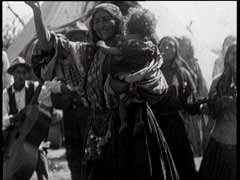
-
Prison in the Warsaw ghetto
FilmAfter the Germans established the Warsaw ghetto in 1940, the Jewish council in Warsaw became responsible for the full range of city services inside the ghetto area. In this German footage, prisoners from the ghetto's "Jewish prison" run into the courtyard and walk in circles during inspection.

-
Protest in Bergen-Belsen displaced persons camp over return of "Exodus 1947" passengers
FilmIn July 1947, 4,500 Jewish refugees left displaced persons camps in Germany and boarded the "Exodus 1947" in France. They attempted to sail to Palestine without, however, having British permission to land. The British intercepted the ship and forcibly returned the refugees to Germany. This footage shows a protest in the Bergen-Belsen displaced persons camp in the British occupation zone of Germany. The protesters denounced British treatment of the "Exodus 1947" passengers. The plight of the "Exodus"…
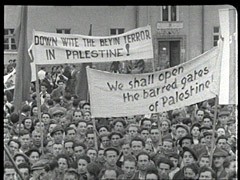
-
Reactions to film shown at Nuremberg
FilmThe film "Nazi Concentration Camps" was presented in the courtroom on November 29, 1945, and entered as evidence in the trial. It was filmed as Allied troops liberated the concentration camps. This clip shows the reactions of defendants and others in the courtroom following the screening of the film.
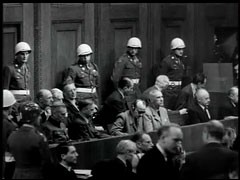
-
Refugees from the "Exodus 1947"
FilmIn July 1947, 4,500 Jewish refugees left displaced persons camps in Germany and boarded the "Exodus 1947" in France. They attempted to sail to Palestine although they did not have permission from British authorities to land. The British intercepted the ship and forcibly returned the Jewish refugees to Germany. Here, Jews from the "Exodus 1947" are confined in Poppendorf, Germany. The plight of the "Exodus" passengers became a symbol of the struggle for open Jewish emigration to Palestine.
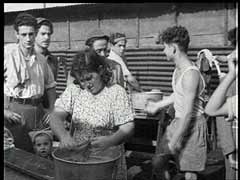
-
Reichstag fire
FilmThis footage shows the Reichstag (German parliament) building on the day after it was set on fire. While the origins of the fire on February 27 are still unclear, Hitler blamed Communists for the incident. The Reichstag Fire Decree of February 28, 1933, suspended constitutional guarantees. Communist and Socialist deputies were expelled from the parliament. Shortly after the decree was issued, the Nazis established concentration camps for the internment of political opponents.
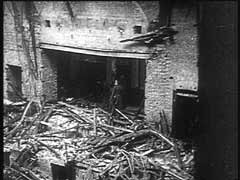
-
Reichstag fire trial
FilmOn the night of February 27, 1933, an unemployed Dutch construction worker named Marinus van der Lubbe set fire to the Reichstag (German parliament) building, causing serious damage. The Nazis blamed the Communists for the fire and claimed emergency powers to crush all opposition. Bolstering Nazi claims, the police also arrested three Bulgarian members of the Communist International, who were in Germany at the time, and a leading German Communist. Despite Nazi claims, however, responsibility for the fire…
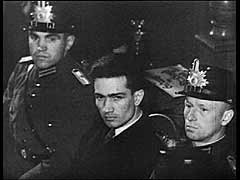
-
Relocation of Soviet Citizens
FilmGerman forces launched Operation "Barbarossa," the invasion of the Soviet Union, on June 22, 1941. The German army made rapid initial progress in the campaign into Soviet territory. In this German military footage, German soldiers separate women and children from men in a Soviet village.
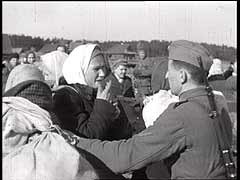
-
Remilitarization of the Rhineland
FilmProvisions of the 1919 Treaty of Versailles forbade Germany (defeated in World War I) to station armed forces in a demilitarized zone in the Rhineland—a region in western Germany bordering France, Belgium, and part of the Netherlands. The treaty stipulated that Allied forces—including US troops—would occupy the region. In a blatant violation of the treaty, on March 7, 1936, Hitler ordered German troops to reoccupy the zone. Hitler gambled that the western powers would not intervene. His action…
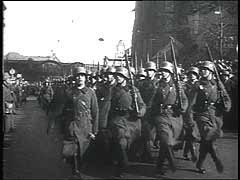
-
Roma (Gypsies) in Romania
FilmAbout a million Roma (Gypsies) lived in Europe before World War II. The largest Romani community—of about 300,000—was in Romania. This film shows a Romani (Gypsy) community in Moreni, a small town northwest of Bucharest. Many Roma led a nomadic lifestyle and often worked as small traders, craftsmen, merchants, laborers, and muscians.
